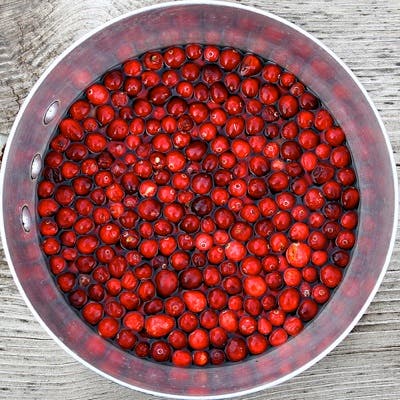
Cranberries: Not Just For Thanksgiving
Once a year, they're scooped from the bogs in which they grow and stuffed into our cabinets: cranberries, the unlikely co-star of Thanksgiving dinner. But when that one annual obligatory meal is over, cranberries disappear, hidden until the next Thanksgiving dinner like a shameful culinary secret or a crazy aunt, chained up in the pantry. It doesn't have to be this way.
Ninety to 95 percent of cranberries are beaten up so badly in the harvest that they have to be dried or turned into juice or canned sauce. But the five to10 percent that are handpicked (the only way to get cranberries undamaged enough to actually serve them fresh) are miraculously tart and have a clean, acidic bite. It's a taste that should have a place at the table beyond Thanksgiving dinner.
Cranberries need sweetening, however, and the big danger is overdoing it: that tooth-shivering holiday cranberry sauce is usually little more than cranberries cooked too long in far too much sugar. One way to sweeten them without spooning on the sugar is roasting. Roasted cranberries and Brussels sprouts might seem like a weird combination, but the earthy crunch of the mini cabbages balances cranberries' acidity. Another beautifully balanced dish is deep-fried feta cheese with cranberry-ginger compote, in which the acidic berries cut the salty bite of the cheese.
Because they need to be sweetened, cranberries are a natural in desserts. Fill the cookie with a lot of other flavors like oatmeal and toffee or use dried cranberries in scones, where they add much-needed punch.
Of course, one of the most popular pairings for cranberries is vodka. Cape Cods use cranberries all-year round, and now that pickling is the latest craze, shouldn't you get ahead of the curve by using cranberries to pickle yourself? Maybe you'll even devise a cocktail with pickled cranberries in it.
Buying Tips
Season: Handpicked cranberries are harvested from late September through early November. Late-season cranberries create the prettiest dishes, since they're allowed to mature to their distinctive, deep red color. Water-picked cranberries are harvested slightly earlier in the season and are not as red.
Where to find it: Massachusetts and Wisconsin are the two top cranberry producers, but you'll find fresh cranberries in most Northern states, especially at farmer's markets in October and November. The rest of us have to make do with frozen whole cranberries (which aren't all bad) or dried cranberries if the recipe calls for them.
Price: You can get fresh cranberries for about $3 a pound, slightly more and slightly less in some regions, depending on your local farmers.
Amanda Cohen is the chef and owner of Dirt Candy, a vegetarian restaurant in New York City.
Keep Reading
Continue to Next Story










